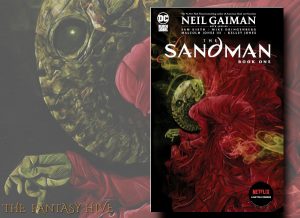THE SANDMAN: BOOK ONE by Neil Gaiman (BOOK REVIEW)
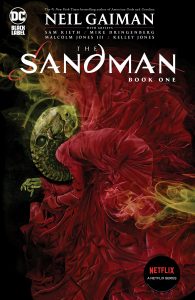 The Sandman: Book One – written by Neil Gaiman.
The Sandman: Book One – written by Neil Gaiman.
Artists: Sam Kieth, Mike Dringenberg, Malcolm Jones III, Chris Bachalo, Michael Zulli, Steve Parkhouse, Kelley Jones, Charles Vess, Colleen Doran.
Colourists: Daniel Vozzo, Steve Oliff. Letterer: Todd Klein. Collection cover and original series covers: Dave McKean (1988-1990)
“I am a passenger. I am moving through your dreams. I am riding in your dreams. I ride on dragonback from Manhattan; the dragon is made of rivetted iron and smells of cotton candy. I travel briefly by bus: in the back the dreamer copulates desperately, not noticing his autonomous passenger. I sit at the front and talk to the driver. Approaching the state of Delaware, the dreamer is a small dog, dreaming impatiently of a past life, long forgotten, when he sailed tall ships across uncharted seas. The salt spray of the ocean stings my face. I am moving through dreams, pulling toward Mayhew, feeling for the jewel. Through your dreams, my sleeping children. You had a passenger, and you never knew.”
The Sandman, a comic series created by author Neil Gaiman and artists Sam Kieth and Mike Dringenberg, was published across 75 issues by DC comics between 1989 and 1996. It is frequently regarded as one of the greatest graphic novels of all time, and one of the crowning achievements of Gaiman’s illustrious career in Fantasy. The series has been hugely influential on Fantasy both in graphic novel and in written form, and with audio and Netflix adaptations emerging in the past year, it remains well loved. The Sandman: Book One is a recently collected anthology that collects the first 20 issues of the comic’s original run, introducing the readers to Gaiman’s characters and world and setting up the initial plot. From the first page of the first issue, it’s easy to see why the series is so enduringly popular and influential.
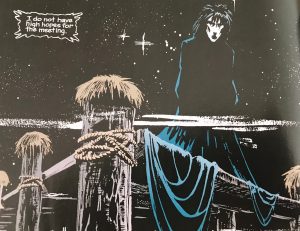
The Sandman’s lead character is Dream, the anthropomorphised god of dreams and one of the Eternals. The first comic opens with Dream being imprisoned by cultists, who were hoping to summon his older sister Death and bargain for immortality. Trapped for decades, Dream calmly waits out his captors, until the eldest dies of old age and his son eventually makes a fatal mistake allowing Dream to escape and carry out his revenge. Upon his release, Dream and his kingdom of dreams are weakened, and he must go on a quest to recover his mask, his bag of sand and his ruby moonstone so that he can regain his full power and restore order. For the King of Dreams’ absence has had a catastrophic effect in the real world, where Dream being unable to perform his duties has led to many mysterious sleep-related ailments, deaths and madness.
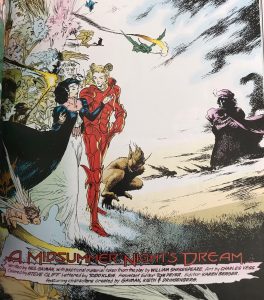 From this relatively straightforward concept, Gaiman and his collaborating artists, which over the course of the first 20 issues includes Kieth and Dringenberg as well as Malcolm Jones III, Chris Bachalo, Michael Zulli, Steve Parkhouse, Kelley Jones, Charles Vess, Colleen Doran and David McKean, weave a complex world exploring the importance of dreams and stories in being human. Gaiman and his collaborators gleefully mix influences and references from high brow to low brow. Dream gets Shakespeare to write A Midsummer Night’s Dream for the entertainment of the fae, and meets up with John Constantine, the Scarecrow and other characters from the DC comics universe. In the comic’s witty dialogue and lush illustrations you can find references to romantic poetry and goth rock, as historical figures mix with literary characters and comic book creations in a joyous riot of story.
From this relatively straightforward concept, Gaiman and his collaborating artists, which over the course of the first 20 issues includes Kieth and Dringenberg as well as Malcolm Jones III, Chris Bachalo, Michael Zulli, Steve Parkhouse, Kelley Jones, Charles Vess, Colleen Doran and David McKean, weave a complex world exploring the importance of dreams and stories in being human. Gaiman and his collaborators gleefully mix influences and references from high brow to low brow. Dream gets Shakespeare to write A Midsummer Night’s Dream for the entertainment of the fae, and meets up with John Constantine, the Scarecrow and other characters from the DC comics universe. In the comic’s witty dialogue and lush illustrations you can find references to romantic poetry and goth rock, as historical figures mix with literary characters and comic book creations in a joyous riot of story.
Over the course of the 20 issues, Dream, like Terry Pratchett’s Death, begins to become more and more human as he interacts with people as part of his professional function as the king of dreams, an immortal anthropomorphisation of a terrifying abstract concept learning warmth and humanity from the people he interacts with. The story is epic in scope, with Dream traveling to Hell and challenging Lucifer in his own domain, stopping Elizabethan occultist John Dee from consuming the world in chaos with the ruby moonstone, hunting down the terrifying nightmare Constantine at a serial killer convention.
 Along the way, we meet some of the other Eternals, particularly Death, who manifests as a perky teenage goth girl who regularly provides emotional support and wisdom to guide Dream, and Desire, an androgynous beauty with a manipulative streak. One can see echoes and premonitions of Gaiman’s Fantasy novels, particularly his epic American Gods (2001), which treads similar thematic ground. With its high-cheekboned antihero with a terrible fate the influence of Michael Moorcock’s Elric stories is strong, and the Elementals as a supernatural family with strange alliances vying for control of mystical realms bring to mind Roger Zelazny’s Amber.
Along the way, we meet some of the other Eternals, particularly Death, who manifests as a perky teenage goth girl who regularly provides emotional support and wisdom to guide Dream, and Desire, an androgynous beauty with a manipulative streak. One can see echoes and premonitions of Gaiman’s Fantasy novels, particularly his epic American Gods (2001), which treads similar thematic ground. With its high-cheekboned antihero with a terrible fate the influence of Michael Moorcock’s Elric stories is strong, and the Elementals as a supernatural family with strange alliances vying for control of mystical realms bring to mind Roger Zelazny’s Amber.
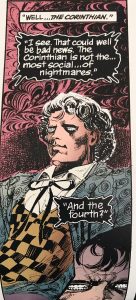 The Sandman sits on the boundary between Fantasy and Horror, fitting for a story about the king of dreams. Dreams represent the unbridled human subconscious, and when they roil and bubble to the surface, they frequently result in violence and mayhem. The sequence in the ‘Preludes and Nocturnes’ arc where Dee takes the customers of a 24 hour diner hostage and uses the ruby to control them, forcing them to reveal their deepest intimacies and commit acts of sexual and violent transgression, is particularly disturbing.
The Sandman sits on the boundary between Fantasy and Horror, fitting for a story about the king of dreams. Dreams represent the unbridled human subconscious, and when they roil and bubble to the surface, they frequently result in violence and mayhem. The sequence in the ‘Preludes and Nocturnes’ arc where Dee takes the customers of a 24 hour diner hostage and uses the ruby to control them, forcing them to reveal their deepest intimacies and commit acts of sexual and violent transgression, is particularly disturbing.
Similarly, the sequence in ‘The Dolls House’ arc where Dream tracks down the Corinthian at a serial killers convention does not hold back on the sadistic violence of serial killers, albeit tempered with some very dark humour as the convention is very clearly based on SFF cons, right down to the subject matter for the panels. However, the darkness is countered by moments of sheer beauty and wonder, such as ‘A Dream of a Thousand Cats’, where a cat tries to change the world through the power of dreams, or the fair folk delighting in and joining in with Shakespeare’s ‘A Midsummer Night’s Dream’ in the story of the same name. For the human subconscious is also the source of daydreams, fantasy and wonder. Gaiman and his collaborators beautifully capture both sides of the human psyche in glorious full-colour detail. Some 34 years after the first issue’s release, The Sandman maintains the brilliance, inventiveness and charm that make it a classic of modern Fantasy.
